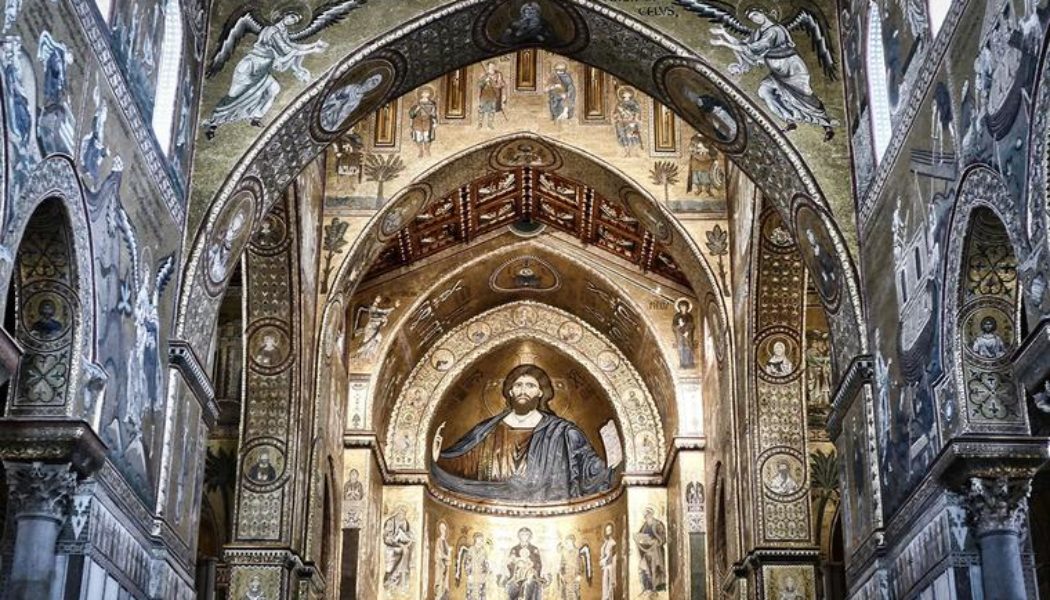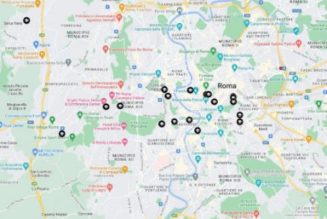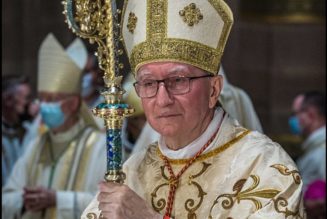
Some of my earliest and happiest memories are those of my mother taking me to weekday liturgies at the tiny Byzantine Catholic parish of Saint John Chrysostom in Columbus, Ohio. Though the entire family attended liturgy together on Sundays, it was on weekdays that my mom was able to quietly teach me what was going on — what was taking place at each part of the liturgy.
If you see pictures of the parish church today, you will see an architectural marvel — albeit a small one — with golden domes, a curved blue roof, and stained-glass windows encircling the upper structure. Inside, you will see peach-colored walls adorned with icons of the saints, a blue-and-white ceiling with golden stars, a massive icon of Mary on the wall in front of the altar, the doors of a majestic golden iconostasis and the inside of the dome featuring an icon of Jesus surrounded by the Apostles.
You will see all that, but I see something you do not see. I’ll come back to that in a moment.
When I was growing up in the early 1970s, this church had not yet been built. Our church was a structure that now sits directly behind the current church. It was a nondescript brick building accented with a few small horizontal windows. It was even less impressive inside. All in all, it was remarkably unremarkable, except for one thing: it was the home of Jesus.
It was there — through the Divine Liturgy of Saint John Chrysostom — that I received the sacraments in my infancy and learned my faith. It was there that our parish priest confected the Eucharist. It was there that I received the Body, Blood, Soul and Divinity of Christ in Holy Communion. It was there that I learned that Jesus loved me.
Sometime during the 1970s, it was decided that we needed a new church, and it was hoped that all the parishioners would contribute to it. My mother and father were — at least on a relative basis — materially poor during my childhood, so their contributions probably took the form of nickel and copper coins rather than paper. For them, even that was a sacrifice. But when I walked into the new church for the first time, I sensed that they had somehow helped build it. When I see the church today, I see the hands of my poor Catholic parents reaching into their pockets for tiny contributions.
Visually, the two churches of my childhood could not have been more different, yet liturgically, they were precisely the same. Whether surrounded by brick walls or golden domes, the liturgy was the constant — the constant and joyful teacher. Through the liturgy, I was learning about God, his love for me, and the loving intercession of Mary, with prayers such as these:
“We give thanks to You, O Master, lover of mankind, benefactor of our souls, that this day You have deemed us worthy of Your heavenly and immortal mysteries. Make straight our path, confirm us in our fear of You, guard our life, make firm our steps, through the prayers and intercession of the glorious Mother of God and ever-Virgin Mary, and of all Your saints.”
“It is truly proper to glorify You, who have borne God, the Ever-Blessed and Immaculate, and the Mother of our God. More honorable than the Cherubim and beyond compare more glorious than the Seraphim, who, a Virgin, gave birth to God the Word; You, truly the Mother of God, we magnify.”
“Christ our true God, Who has risen from the dead, through the prayers of His most pure Mother, and of our holy Father, John Chrysostom, archbishop of Constantinople, and of all the saints, will have mercy on us and will save us, for He is gracious and loves mankind.”
In so many ways, the Byzantine liturgy has shaped and formed me in its spiritual womb, and continues to do so.
This earth is not our home. But if it could be said that every Christian on earth is homeless, it is through the liturgy that we transcend this mortal coil and feel at home. And that is a very good and proper feeling.
A few years ago, I was reminded that I was not the only person who felt that way. For various reasons, we had not attended our Byzantine parish church in months. During that time, we had attended other Masses and liturgies — beautiful in their own rights and respects — but I sorely missed the prayers of the Eastern liturgy. Eventually, we returned one Sunday morning to our home parish. And when my 15-year-old daughter, Dominica, walked through the doors and looked around in the church that she had not seen for several months, she happily whispered to her younger brother, “We’re home.”
I was reliving these happy memories recently after I heard about Pope Francis’ new restrictions on the Latin Mass. Selfishly, I was wondering what my life would have been like without the Byzantine liturgy, without the liturgy being a part of our children’s lives, and what the world would be like if the Divine Liturgy of Saint John Chrysostom were suddenly removed or made more difficult to access. And then my thoughts turned to so many of my friends who need not wonder, for with the new motu proprio of Pope Francis, this may be their new reality.
In the discussion about the recent motu proprio, some critics have objected that Rome is focused on unity too much, but I would argue that it is not focused on unity enough. It fosters a sense of unity to ponder that St. Teresa of Ávila, St. Margaret Mary Alacoque, and St. Kateri Tekakwitha — once members of the Church Militant and now members of the Church Triumphant — prayed at the same essential Latin liturgy that now finds itself in jeopardy.
That seems odd, because when we speak of that “unity” which is a mark of the Church, we are not referencing the lack of differences in various liturgical celebration. The Catholic Encyclopedia explains that “accidental differences in ceremonial forms do not in the least interfere with essential unity of worship, which is to be regarded primarily and principally in the celebration of the same sacrifice and in the reception of the same sacraments.”
The Second Vatican Council’s document Lumen Gentium goes even beyond the Encyclopedia’s observation:
“Moreover, within the Church particular Churches hold a rightful place; these Churches retain their own traditions, without in any way opposing the primacy of the Chair of Peter, which presides over the whole assembly of charity and protects legitimate differences, while at the same time assuring that such differences do not hinder unity but rather contribute toward it.”
The message is clear: various liturgies — unified in belief — actually foster unity.
Further, Pope St. John Paul II believed that the liturgies of the East and the liturgies of the West form two unifying lungs that oxygenate the heart of the Mystical Body of Christ. Whatever one thinks of the old Latin Mass, there is no denying that it has served as a ventricle of grace for centuries.
In the coming months and years, liturgists will argue the merits and demerits of this motu proprio and its likely effects on the Church. They will argue points of theology, sociology and ecclesiastical history. But for now, my heart goes out to all those children who — since 2007 — have known only the Latin Mass, and have grown to love the Latin Mass. My heart also goes out to their parents, who have quietly taught them about God’s love and mercy through the liturgy. And now, they must pray that their bishop allows — and is allowed — the continued offering of that liturgy.
As a Byzantine Catholic, my prayers will be with them.
Join Our Telegram Group : Salvation & Prosperity








